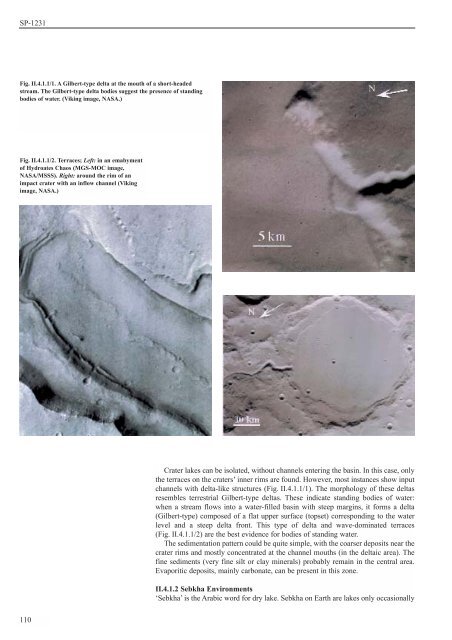Exobiology in the Solar System & The Search for Life on Mars - ESA
Exobiology in the Solar System & The Search for Life on Mars - ESA
Exobiology in the Solar System & The Search for Life on Mars - ESA
You also want an ePaper? Increase the reach of your titles
YUMPU automatically turns print PDFs into web optimized ePapers that Google loves.
SP-1231<br />
Fig. II.4.1.1/1. A Gilbert-type delta at <str<strong>on</strong>g>the</str<strong>on</strong>g> mouth of a short-headed<br />
stream. <str<strong>on</strong>g>The</str<strong>on</strong>g> Gilbert-type delta bodies suggest <str<strong>on</strong>g>the</str<strong>on</strong>g> presence of stand<str<strong>on</strong>g>in</str<strong>on</strong>g>g<br />
bodies of water. (Vik<str<strong>on</strong>g>in</str<strong>on</strong>g>g image, NASA.)<br />
Fig. II.4.1.1/2. Terraces; Left: <str<strong>on</strong>g>in</str<strong>on</strong>g> an emabyment<br />
of Hydroates Chaos (MGS-MOC image,<br />
NASA/MSSS). Right: around <str<strong>on</strong>g>the</str<strong>on</strong>g> rim of an<br />
impact crater with an <str<strong>on</strong>g>in</str<strong>on</strong>g>flow channel (Vik<str<strong>on</strong>g>in</str<strong>on</strong>g>g<br />
image, NASA.)<br />
110<br />
Crater lakes can be isolated, without channels enter<str<strong>on</strong>g>in</str<strong>on</strong>g>g <str<strong>on</strong>g>the</str<strong>on</strong>g> bas<str<strong>on</strong>g>in</str<strong>on</strong>g>. In this case, <strong>on</strong>ly<br />
<str<strong>on</strong>g>the</str<strong>on</strong>g> terraces <strong>on</strong> <str<strong>on</strong>g>the</str<strong>on</strong>g> craters’ <str<strong>on</strong>g>in</str<strong>on</strong>g>ner rims are found. However, most <str<strong>on</strong>g>in</str<strong>on</strong>g>stances show <str<strong>on</strong>g>in</str<strong>on</strong>g>put<br />
channels with delta-like structures (Fig. II.4.1.1/1). <str<strong>on</strong>g>The</str<strong>on</strong>g> morphology of <str<strong>on</strong>g>the</str<strong>on</strong>g>se deltas<br />
resembles terrestrial Gilbert-type deltas. <str<strong>on</strong>g>The</str<strong>on</strong>g>se <str<strong>on</strong>g>in</str<strong>on</strong>g>dicate stand<str<strong>on</strong>g>in</str<strong>on</strong>g>g bodies of water:<br />
when a stream flows <str<strong>on</strong>g>in</str<strong>on</strong>g>to a water-filled bas<str<strong>on</strong>g>in</str<strong>on</strong>g> with steep marg<str<strong>on</strong>g>in</str<strong>on</strong>g>s, it <str<strong>on</strong>g>for</str<strong>on</strong>g>ms a delta<br />
(Gilbert-type) composed of a flat upper surface (topset) corresp<strong>on</strong>d<str<strong>on</strong>g>in</str<strong>on</strong>g>g to <str<strong>on</strong>g>the</str<strong>on</strong>g> water<br />
level and a steep delta fr<strong>on</strong>t. This type of delta and wave-dom<str<strong>on</strong>g>in</str<strong>on</strong>g>ated terraces<br />
(Fig. II.4.1.1/2) are <str<strong>on</strong>g>the</str<strong>on</strong>g> best evidence <str<strong>on</strong>g>for</str<strong>on</strong>g> bodies of stand<str<strong>on</strong>g>in</str<strong>on</strong>g>g water.<br />
<str<strong>on</strong>g>The</str<strong>on</strong>g> sedimentati<strong>on</strong> pattern could be quite simple, with <str<strong>on</strong>g>the</str<strong>on</strong>g> coarser deposits near <str<strong>on</strong>g>the</str<strong>on</strong>g><br />
crater rims and mostly c<strong>on</strong>centrated at <str<strong>on</strong>g>the</str<strong>on</strong>g> channel mouths (<str<strong>on</strong>g>in</str<strong>on</strong>g> <str<strong>on</strong>g>the</str<strong>on</strong>g> deltaic area). <str<strong>on</strong>g>The</str<strong>on</strong>g><br />
f<str<strong>on</strong>g>in</str<strong>on</strong>g>e sediments (very f<str<strong>on</strong>g>in</str<strong>on</strong>g>e silt or clay m<str<strong>on</strong>g>in</str<strong>on</strong>g>erals) probably rema<str<strong>on</strong>g>in</str<strong>on</strong>g> <str<strong>on</strong>g>in</str<strong>on</strong>g> <str<strong>on</strong>g>the</str<strong>on</strong>g> central area.<br />
Evaporitic deposits, ma<str<strong>on</strong>g>in</str<strong>on</strong>g>ly carb<strong>on</strong>ate, can be present <str<strong>on</strong>g>in</str<strong>on</strong>g> this z<strong>on</strong>e.<br />
II.4.1.2 Sebkha Envir<strong>on</strong>ments<br />
‘Sebkha’ is <str<strong>on</strong>g>the</str<strong>on</strong>g> Arabic word <str<strong>on</strong>g>for</str<strong>on</strong>g> dry lake. Sebkha <strong>on</strong> Earth are lakes <strong>on</strong>ly occasi<strong>on</strong>ally

















